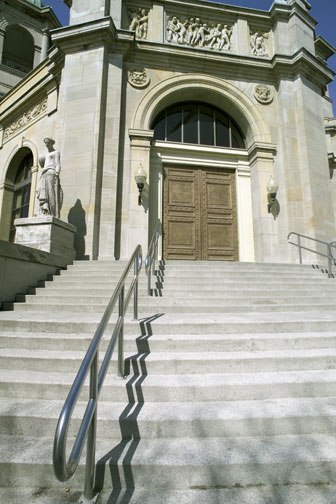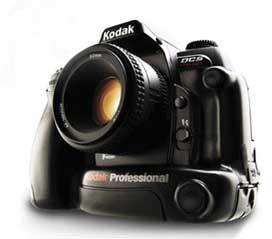
You will find part one of this review here
Sunday, March 23, 2003
I ended yesterdays first part of this initial review of the Kodak DCS 14n with the comment that I wouldn’t be doing any further comparisons with the Canon EOS 1Ds. But, since then I have received a number of complaints, comments and suggestions. Therefore, in addition to doing some straightforward photography with the 14n I ran a second round of tests. Here are some of the e-mails I received and my responses:
You only used one lens on the 14n, a medium range zoom.
I also only used one lens on the 1Ds. But, today I shot with a Nikon 20mm f/2.8 prime and also a Nikon 80-200mm f/2.8 zoom as well as the 28-70mm f/2.8 zoom.
You only shot with a Nikon lens. Sigma lenses are better. You should redo the test with Sigma lenses.
Right!
Regrettably I only have Nikon lenses available for testing. Sorry.
You did your work on a PC under Windows. You should have used a Mac under OS X.
I never mentioned what platform I used, but he’s right, it was a Win XP machine. Ok. All of today’s work is done on a Mac under OS X. (Sarcasm alert — just like the item above it. Too many people have taken this seriously)
You are biasing the results by using Phase One’sCapture Onesoftware on the 1Ds files. You should use Canon’s RAW conversion software.
Since this is currently the most popular RAW converter among 1Ds owners, I don’t think so. But, just to be fair all of today’s comparisons were done with 1Ds files converted inAdobe’s Camera RAW. I did not use, and won’t, Canon’s RAW conversion software because I find it almost unusable.Kodak’s Photo Deskwas used for 14n files because it is the only RAW software currently available for this camera. (Actually it isn’t. Camera RAW can read 14n RAW files but I did some some tests which showed that the results are much noisier than those from the Kodak software, so it wasn’t used in any of today’s tests).
All of your shooting was done on a cloudy day or indoors. The 14n is much better in bright sunlight.
Well, I appealed to a higher authority (not Kodak — higher than that) to provide a sunny day. All of today’s shooting was done in bright sunlight, and as you’ll see I’m glad it was.
Your online JPGs are compressed too much making comparisons difficult for viewers.
I agree. All files on this page today therefore have minimal compression. This may make the page slower to load for people without high-speed connections.
You are not using the latest firmware in the 14n. There is a new version about to become available.
When I left to shoot this morning I was still working with Revision 4.0.2, the one installed in the camera that was shipped from Kodak 2 days ago. But, Jay Kelbley of Kodak kindly e-mailed me the latest version, 4.1.2, and I installed it and ran additional tests in the afternoon. I have been told that this new version of the Firmware will be released this week, and that it is the version that will be included in cameras that ship to initial purchasers.
____________________________________________________
I went out on this early spring day thinking about a comment made to me the day before by another reviewer,Peter Burian. He had said that in bright light and at ISO 80 his experience had been that the Kodak 14n produced excellent results. Since the day was sunny I was eager to see if he was right.
He was right, and I’m ready to eat some crow. Below you see two frames done at ISO 80 with the 14n and ISO 100 with the 1Ds. ANikon ED 80-200mm f/2.8 Dlens was used on the 14n, and aCanon 70-200mm f/2.8L ISon the 1Ds. The 14n image is superlative. Excellent colour rendition, terrific sharpness and no visible noise.


Below are 100% crops from the above frame. What I see is that the 14n image is visibly superior; less contrasty, has slightly more resolution and a bit more shadow detail.

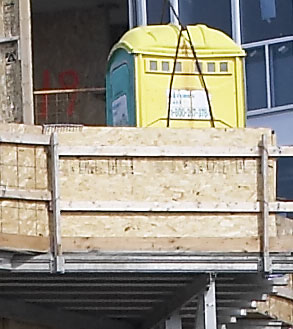
I did quite a few more frames at ISO 80, with this lens, as well as the Nikon 28-70 f/2.8 and the 20mm f/2.8 D. I have don’t have the time or inclination to reproduce them here, but many hours of image processing, printing and comparisons bares out the following — at ISO 80 and in bright sun light the Kodak 14n and the Canon 1Ds are very similar in image quality. Sometimes the Kodak seems to be slightly better and sometimes the Canon does. The Kodak always has a larger file of course and appears to have slightly better resolution. I saw no moire with either camera, though frankly I wasn’t particularly looking or testing for it . (Next time).
But — and it’s a big but — especially at ISO 400, and at slower and slower shutter speeds the Kodak falls rapidly behind. You’ll see below in my testing of the new firmware release at ISO 400, that at this speed the 1ds loses very little if any image quality while the 14n really deteriorates.
____________________________________________________
Firmware Version 4.0.2
As noted at the top of this page, after I’d been out much of the day shooting with the 14n I returned to my office to discover that Kodak had e-mailed me the latest firmware, Revision 4.1.2. Before installing it I took several additional photographs with the original firmware. I then installed the new firmware and repeated these shots. I did them as well with the 1Ds.
Below you see the first of these tests. This photograph of a bookshelf was taken in my office, illuminated by window light. The 14n and 1Ds frames were both done at 50mm with the same 28-70mm and 24-70mm Nikon and Canon zooms lenses used yesterday. The shots were taken at ISO 400, which is where the 14n shows its greatest weakness. I wanted to see if the new firmware exhibited any improvement and figured this is where it was needed most.

The two frames below are 100% crops taken from frames taken with the Kodak 14n. I find colour fidelity to be weak and images done under both the old and new firmware to be very noisy. Surprisingly the one with the earlier firmware revision seems to be somewhat sharper. Otherwise I see little difference in the noise level.
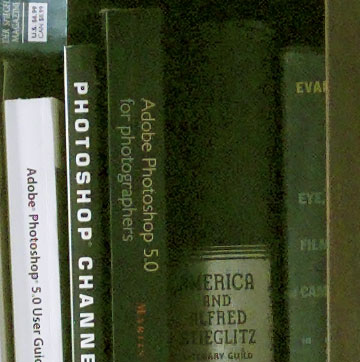
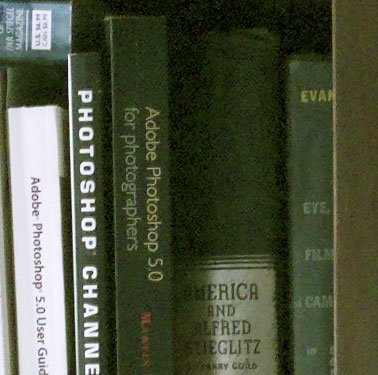
ISO 400 f/5.6 1/4 second
ISO 400 f/5.6 1/4 second
The 1Ds shot below was also done at ISO 400 and with the same exposure. Colour fidelity is good, and while some slight noise is seen, it is quite acceptable.
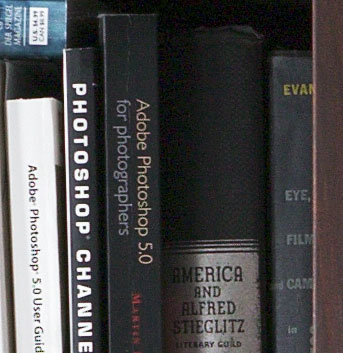
I did notice a few small improvements with the new firmware. For example, the monochrome information panel LCD on the rear of the camera would be garbled on boot-up with 4.0.2. With the new firmware it displays the camera model number. There are other small improvements but I regrettably I wasn’t able to explore them all this time.
____________________________________________________
Features / Functions / Ergonomics
Any evaluation of a camera’s features, functions and ergonomics is of necessity subjective. There are no Platonic ideals or absolutes when it comes to camera design. Therefore what you’re about to read is simply my opinion on these matters. I bring no special expertise to this task, other than that I’ve been doing photography for about 35 years and have been using 35mm SLRs since my first Pentax Spotmatic in the 1960’s. I have owned and used a large succession of Nikon Fs, Minoltas, Contaxes and Canon’s, not to mention Leicas, Hasselblads and Rolleis.
Ergonomics
Since a camera is primarily a tool (though also as a fetish object for some), how it comes to hand and performs its tasks is very important, especially for the professional or prolific photographer shooting many thousands of frames a year. Even small design deficiencies can become major annoyances (at best) or serious impediments (at worst) over time and with heavy use.
Initial impressions of the Kodak 14n are mixed. On picking one up its light weight relative to its bulk is noted first, followed by its chunky design. "Chunky" is a charitable designation. I’ve heard it called worse. One long time camera salesman who is usually quite circumspect described it as a Nikon F80 sitting in a bathtub. This is due to the fat base appendage that surrounds the bottom of the camera body.
Simple esthetics aside (and I have already commented on this inpart oneof this review) the body’s design does present some operational issues. One is that the rear control and LCD panel juts pretty far back from the eyepiece. This means that ones nose is hard pressed against either the LCD glass or one of the control button. I have found myself constantly turning on the rear LCD display with my nose, as it presses against theMenubutton almost every time that I looked though the viewfinder. Less of an issue for me than it might be for some is that the LCD is constantly coated in nose oil. Not to put too fine a point on it, but you really have to mash the camera up against your face to be able to clearly see through the viewfinder.
I won’t comment particularly on aspects of the camera that are inherent in its Nikon F80-based design. Nikon users will be comfortable with the controls and will find them in the expected places, and that they do the expected things.
One item that I found to be a problem is that the shooting mode dial on the top left of the body has an ISO setting position along with the usualM A SandPmodes. My issue with this is that if you accidentally leave the dial in the setting position the camera can not be fired, and there is no indication of why. The shutter just won’t release. A much preferable design would be to spring load the ISO dial position so that it can’t be accidentally left set there. ISO can also though be set via the rear LCD menu system. Make this mistake once or twice and you’ll likely revert to this somewhat slower though safer method.
I also was not pleased to note that going into shooting mode (by pressing the shutter release) does not turn off the rear LCD. The camera does operate immediately without changing any mode switches, as it should, but one has to explicitly turn off the LCD. I found it very annoying to have the bright LCD illuminated just below my line of sight when working in low light levels. There may be a way of turning this off in software, but I couldn’t find it.
I won’t detail all of the button and menu controls. I’ll leave it to other reviewers who excel in itemizing every knob and wart, and cataloging their functions. You can also download a PDF of the 14n’s manual from the Kodak web site and read about them there.
Some observations that I have though are that while the LCD is, of course, in colour when displaying taken images, in menu mode it is in black and white. This does make it brighter than it otherwise might be, but it does look quite plain. I also find the characters on the small sub-LCD to be very fine and more difficult to read than they might be.
The rechargeable battery provided with the 14n is Lithium Ion, and it recharges quickly. That’s the good news. The bad news is that it doesn’t last very long at all. I charged the battery and discharged it fully and then charged it again overnight. After taking about 50 frames this morning the battery indicator was flashinglow. This was in an ambient temperature of about 50 degrees F (10 C). My suggestion to anyone working away from easily accessible AC power would be to buy 2, 3, 4 or more batterys to ensure that one has along at least a full day’s worth of power.
On a positive note I found the shutter noise to be remarkably low. But I was concerned to note that the 14n does not have mirror lock-up capability. This could be a real impediment to anyone working with long lenses or doing sensitive macro work. I would have added slow shutter speed use to the list, but the camera is currently unable to produce usable images at the shutter speeds where mirror lock up is usually preferred.
The camera has a vertical shutter release that is activated via a menu selection and the firmware knows if the camera is being held vertically or horizontally, and rotates the images accordingly. This capability is now showing up more and more on DSLRs and digicams, and parenthetically, it’s a serious oversight that it isn’t featured on the Canon 1Ds. I wish it were. But, the vertical release button is poorly located. It is horizontal on the surface of the grip and requires a long reach with ones index finger. It should have been canted.
Due to time constraints I will have to reserve my comments on the camera’s extensive menu system and thePhoto Desksoftware until I receive my formal review sample in a week or so.
____________________________________________________
Ultra-Wide
Kodak 14n with Nikon 20mm f/2.8 D lens
ISO 80. 1/125 sec. f/11
This frame was taken with one of Nikon’s best ultra-wide lenses, the 20mm f/2.8. The image is a sharp and detailed and as lacking in artifacts as any I’ve ever seen. This is a brilliant lens and together with 14n puts the lie to supposed problems with ultra-wide lenses and full-frame sensors.
Sounds like things are looking up, right? Unfortunately not for long.
____________________________________________________
Chromatic Aberration?!
Many web pundits on the various discussion forums love to speculate on the reasons for what they are seeing in such tests. They pick their favourite hobby horse and ride it off into the sunset. The example below shows how hard it actually is to make sense of tests like these beyond simply recognizing certain problem’s existence.
This shot was taken into a very heavily back-lit scene. The lens is one of Nikons finest, well regarded and utilizing ED glass, which should prevent it from displaying pretty much any chromatic aberration. The common wisdom is that the chromatic aberration that we sometimes see with digital cameras isn’t caused the sensor itself, but the ability of digital sensors to reveal aberrations that are inherent in the lens used, but otherwise hidden by the characteristics of film.
OK my friends, then what has caused the absolutely unexpected and appalling CA that is seen in this frame?
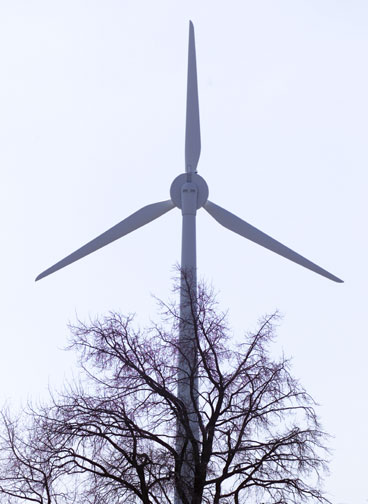
@ ISO 125. 1/1500 sec @ f/5.6
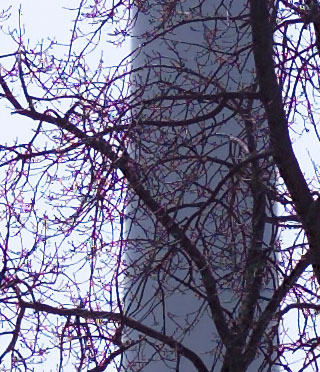
I’m stumped. It clearly is caused by a combination of the 14n’s sensor and the particular lighting situation found in this particular frame, but I’ll be damned if I can explain it. Will all lenses display CA like this with the 14n under certain lighting conditions? Is it only this particular lens or model? Is this problem known by Kodak and will it be fixed in future firmware releases?
Feel free to speculate, but if you find out for sure, please let me know.
Update:I’ve now been informed by several technically savvy correspondents that what we are seeing here is colour aliasing caused by the lack of an anti-aliasing filter. This may be the price that is paid for not including an AA filter in the camera’s design, and it may well be that the use of an AA filter in front of the lens turns out to be the only solution, though given how expensive these are, and the problems of mounting one on a variety of lens sizes, I’m not sure how well this could work.
____________________________________________________
Turn On Time
Other than in a studio setting, turn-on time can be an important issue. On the 1Ds it takes approximately 1 second from the time you turn on power until you can fire the shutter. On the 14n (Revision4.0.2) this took 13 seconds. Under Revision4.1.2this has been reduced to 10 seconds. This simply isn’t good enough for me, and I doubt many other photographers working outside the studio will find it so either. This is the turn-on time of a consumer digicam, not a $5,000 professional camera.
____________________________________________________
Price Vs Build Quality
No examination of the Kodak 14n would be complete without a look at its price / quality ratio, and also where it fits into the current commercial spectrum. Kodak’s protestations aside the 14n is primarily based on theNikon F80, a camera which retails in the U.S. for approximately $350. This means that the digital side of the 14n (Kodak’s contribution) represents more than $4,500 of the $5,000 retail price, or more than 90%.
Given the high cost and difficulty of fabricating full frame sensors there’s nothing inherently wrong with this equation, except when seen on an absolute scale. With the digital aspect aside for the moment, one is paying $5,000 for the same photographic tool that someone who is shooting film will pay $350 for. Now, if we put the digital side back in, what has changed? From the perspective of the 14n as a photographic tool, almost nothing. It still is simply an inexpensive consumer-grade camera.
Can the same be said of aNikon D1x,D1horCanon 1Dor1Ds? No, I don’t think so. (TheKodak DCS 760would have been included in this list but it was recently discontinued).The reason why is that these cameras essentially represent the state of the art that camera makers are capable of. One simply can’t buy better metering, autofocus, shutter reliability, weatherproofing or build quality, to name just a few aspects. These cameras are the best cameras that two of the world’s leading manufacturers know how to make — atanyprice.
Regardless of how these Nikon or Canon cameras compare, either to their film-based predecessors or to each other, onecansay that the photographer is getting the finest tool that anyone know how to design or build — again, with the digital aspect aside for the moment. Now add the digital component (what Kodak brings to the party) and what do you have? In the case of Nikon and Canon, the best digital camera that they are currently able to make, and therefore the best that one can buy from these respective manufacturers. In the case of the Kodak 14n though one may be getting the best digital side that Kodak knows how to make, but one is still simply getting an inexpensive consumer-grade camera body on the non-digital side of the equation.
If the 14n had been a world-beater as a digital image maker then a lot could be forgiven. Photographers would say — OK, it may not be as rugged, or as well built, have the best autofocus, weather sealing, shutter robustness, or metering sophistication as I might like for the money — but it is such a hell of an overall image producer that I’m willing to overlook these shortcomings. But this is regrettably not the case.
____________________________________________________
Preliminary Conclusion
It’s never fun to pan a product. Dozens if not hundreds of employees work hard for years to bring a product like the 14n to market. A company, Kodak in the case, spends many millions of dollars in R&D, and manufacturing infrastructure not to mention significant marketing dollars, and hopes to consequently get a solid return for its shareholders.
But, if a product doesn’t make the grade what is a reviewer to do? Commercial magazines will often simply not publish a review when this is the case. They fear the loss of future advertising revenues. Since I have no such constraints I feel obliged to publish my findings, even though they are not totally complimentary. It’s one things to write that one doesn’t like this or that feature of a product, but in this case I’m forced to draw a darker conclusion.
In its current state, and using the latest software Revision 4.1.2, the Kodak 14n produces stunning images in bright light at ISO 80. These are every bit as good as, and in some ways possibly better than those from the market leading and more expensive Canon 1Ds. But, that’s where the good news ends. At higher ISO ratings image quality decreases and noise increases quickly. Image quality also deteriorates at even moderately low shutter speeds. The strange chromatic aberation that I’ve seen also needs to be better understood.
Looked at just as a camera, putting aside its digital capabilities for the moment, the 14n is not much more than a $350 Nikon in terms of its capabilities as a picture taking machine. Its ergonomic design deficiencies and limitations (such as the lack of mirror lock up) will cause some potential owners concern.
Frankly, as it is currently offered I can not recommend its purchase. Even if the 14n’s total imaging capabilities are brought to a level where it exceeds those of the 1Ds at all ISO settings and shutter speeds it still is a much inferior camera in terms of photographic features and build quality. This may not be a concern for some, but I believe that it will be for many.
If you are invested in Nikon mount lenses, unless a full frame camera is a must for your work, and that work is limited to sunny days and indoor studio use, my suggestion is to look elsewhere. The Nikon D1x is available for about the same money and is a lot more camera. A Fuji S2 Pro or Nikon D100 will likely prove to be a more versatile picture taking tool in a wide variety of situations, and will also cost a lot less money — half as much.
I wish this wasn’t the case. With Nikon apparently not proceeding with a full frame digital camera in the near to mid-term Nikon lens mount owners are left without a versatile full-frame choice. Kodak has taken 6 months since introduction to bring the 14n to market, and right until the last minute it seems that firmware upgrades are needed. It is unclear whether further upgrades will be able to overcome whatever deficiencies the imaging chip may have, and no firmware changes will overcome the fact that the body used as the basis for this camera is not of competitive build quality or features set, especially for the money.
I am anticipating receiving another camera from Kodak for more extensive testing in early April. At that time I will look more closely at the camera’s software controls and image processing software, and plan on revisiting the image quality conclusions that I’ve made, this time with somewhat less of a time constraint.
____________________________________________________
Thanks
I would like to thank the management and staff ofVistekfor allowing me this opportunity to test theKodak 14nahead of the camera’s scheduled release to reviewers. Vistek is Canada’s largest professional photographic dealer and there were a great many photographers and commercial customers eagerly waiting their chance to examine the camera ahead of me. It worked out to be a win-win for both of us, because I wanted the earliest opportunity to test this new camera and they wanted my opinion on its performance and capabilities.
____________________________________________________
One More Thing
There are those who have objected to the harshness of this review and who have raised the point in Kodak’s defense that they describe the 14n as being designed for wedding photographers, commercial applications and studio use. Fair enough, but the implication is that these categories of photographer somehow don’t need ISO capability higher than 80, or slow shutter speeds, or will accept a viewfinder that is difficult to look through. This isn’t reasonable thinking.
Ask a wedding photographer if he’ll be satisfied only shooting at ISO 80. Ask a commercial photographer (whatever that is) to be satisfied with a camera that doesn’t work properly at moderately long shutter speeds.
I can only imagine doing a review of a new automobile with a sidebar of caveats that reads….
This is a fine car, but potential customers should be aware of the following…
—The demo that you test drive isn’t the same as the car you’ll be buying
— The car doesn’t run well in the rain
— The back seat isn’t installed yet
— The heater doesn’t always work properly
— You need to wait a while after you start the car before you can drive away
— You should phone the manufacturer once a week to see if they’ve come up with solutions to these and other problems.
____________________________________________________
Update:I have received a great deal of communication on this review, both private and on various forums. I don’t want to fan the flames any more than necessary. But there are those that are convinced that my findings and impressions are flawed. Partially as support for my position (which I remain resolutely convinced of) and in part because readers have the right to know what others are seeing from their tests, I include below a comment from another person who has done his own 14n testing. (There just aren’t that many yet). I have removed the name of the company because this individual doesn’t speak for them — but is just reporting his own impressions.
I am an employee at (a professional photographic retailer ), Santa Ana CA. We received the Kodak DCS 14n, for our rental department, last week. All I can say is we discovered all of the same problems you did during routine testing before we released it to customers.
I emailed you simply to say thank you for your insightful and honest testing. It is so rare today to find such unbiased and refreshingly straight forward advice and reviews.
Sincerely,
Barry Evans
____________________________________________________
Update:The best review of theKodak 14npublished to date (as of mid-April, 2003) is that fromRob Galbraith. He has investigated the 14n’s capabilities and limitations with a level of thoroughness that is commendable. He has uncovered all of the camera’s same strengths and foibles as I did, but he has taken the time to explain them in greater detail.
Like in this site’s review, Rob compares the 14n to the Canon 1Ds, and for the same reasons. Both are the only 10MP+ full-frame DSLRs on the market at the moment, and both are the leading contenders in the Nikon and Canon lens mounts.
My take on Rob’s review is that he has been as fair as possible to Kodak’s effort. In fact, if anythingtoo fair. Every defect is qualified and explained to such an extent that I wonder why he has bothered. I certainly am not drawing into question Galbraith’s editorial integrity — he is likely the best "real world" DSLR reviewer we have. But by cutting Kodak as much slack as he has the reader is somehow left with the impression that Kodak should be forgiven for this product’s defects. Sorry, but put as plainly as possible — I disagree. The Kodak 14n is far too flawed for Kodak to be givena pass. But, readRob’s reviewand see whatyouthink.
____________________________________________________
Update:
Thom Hogan, the well known Nikon author and authority, has written a verycomprehensive reviewof the 14n using the latest firmware (late July, 2004). He has a fresh and more current perspective, and though I’m still think that the 14n is ultimately a flawed product, I can see that for some photographers willing to live with its limitations, the 14n may not be quite as bad as I first painted it.
____________________________________________________
Thom Hogan’s Review
____________________________________________________
You May Also Enjoy...
Bronica 645
The Bronica RF645 Rangefinder Revisited Last Spring, Bronica sent me a big Pelican case containing an entire Bronica RF645 kit. At the time, I promised
